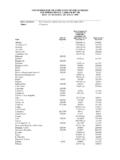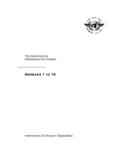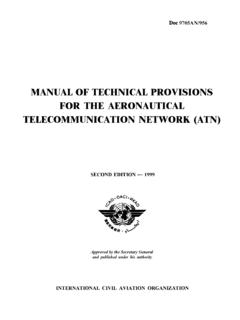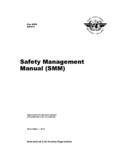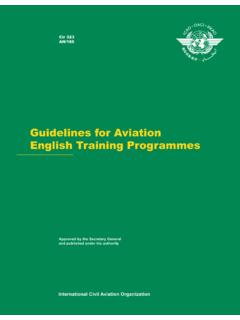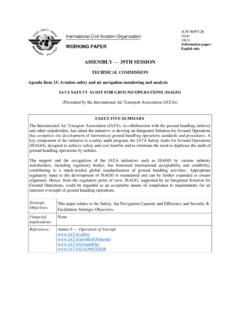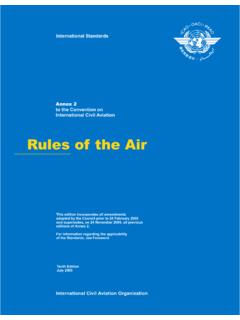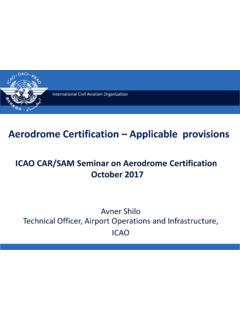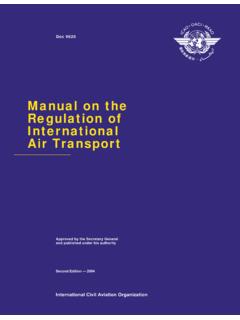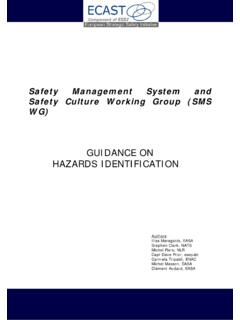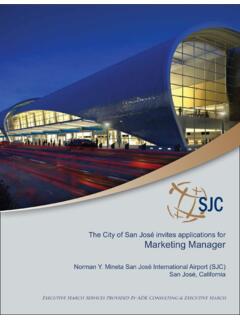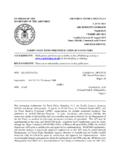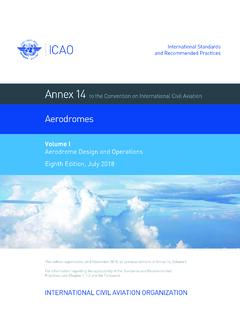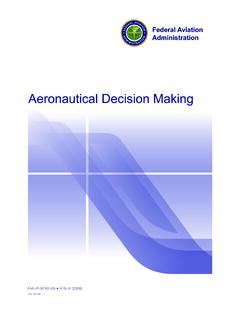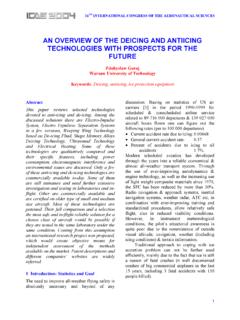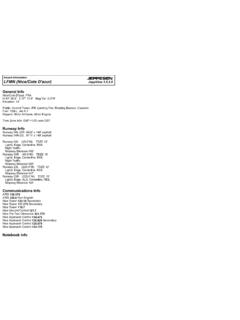Transcription of SAFETY - ICAO
1 SAFETYS tate of Global Aviation SafetyICAO SAFETY Report 2019 Edition33456789102 7 0 2 2019 EditionCoordinated, Risk-based Approach to Improving Global Aviation SafetyThe air transport industry plays a major role in global economic activity and development. One of the key elements to maintaining the vitality of civil aviation is to ensure safe, secure, efficient and environmentally sustainable operations at the global, regional and national specialized agency of the United Nations, the International Civil Aviation Organization (ICAO) was established in 1944 to promote the safe and orderly development of international civil aviation throughout the promulgates Standards and Recommended Practices (SARPs) to facilitate harmonised regulations in aviation SAFETY , security, efficiency and environmental protection on a global basis. Today, ICAO manages over 12 000 SARPs across the 19 Annexes and five Procedures for Air Navigation Services (PANS) to the Convention on International Civil Aviation (Chicago Convention), many of which are constantly evolving in tandem with latest developments and innovations.
2 ICAO serves as the primary forum for co-operation in all fields of civil aviation among its 193 Member the SAFETY of the global air transport system is ICAO s guiding and most fundamental strategic objective. The Organization works constantly to address and enhance global aviation SAFETY through the following coordinated activities: Policy and Standardization; Monitoring of key SAFETY trends and indicators; SAFETY Analysis; and Implementing programmes to address SAFETY ICAO Global Aviation SAFETY Plan (GASP) presents the strategy in support of the prioritization and continuous improvement of aviation SAFETY . The GASP sets the goals and targets and outlines key SAFETY enhancement initiatives (SEIs). These global and regional initiatives are established and monitored on the basis of SAFETY management principles. This year, ICAO publishes a special edition of the annual SAFETY report on the occasion of the 75th Anniversary of the Organization and the convening of the 40th Session of the ICAO Assembly.
3 This special edition, which presents the state of global aviation SAFETY , is structured in alignment with the GASP and the Global Air Navigation Plan (GANP) which provides global strategic guidelines to drive the evolution of the air navigation system. This report provides a comprehensive account of ICAO s SAFETY achievements over the past 75 years and updates on SAFETY performance indicators (SPIs), including accidents that occurred in 2018, and related risk factors. Results of analysis from the 2014 2018 reports are used as benchmarks for comparison, although it must be noted that numbers presented in this report may not exactly match earlier editions due to data updates during the intervening 7 0 2 2019 Edition 2019, International Civil Aviation OrganizationPublished in Montr al, CanadaInternational Civil Aviation Organization999 Robert-Bourassa BoulevardMontr al, Quebec, CanadaH3C report makes use of information, including air transport and SAFETY related data and statistics, which is furnished to the International Civil Aviation Organization (ICAO) by third parties.
4 All third party content was obtained from sources believed to be reliable and was accurately reproduced in the report at the time of printing. However, ICAO specifically does not make any warranties or representations as to the accuracy, completeness, or timeliness of such information and accepts no liability or responsibility arising from reliance upon or use of the same. The views expressed in this report do not necessarily reflect individual or collective opinions or official positions of ICAO Member :The ICAO Regional Aviation SAFETY Group (RASG) regions are used in the report and are listed in Appendix 1. This document focuses primarily on scheduled commercial flights. The scheduled commercial flights data was based on the Official Airline Guide (OAG) combined with internal ICAO preliminary 7 0 2 2019 EditionContentsTable of ContentsForeword ..3 Executive Summary ..6 Aviation SAFETY Milestones over the Past 75 Years ..9 Implementation of Global Aviation SAFETY Plan.
5 13 Effective Implementation of SAFETY Oversight System (SSO) ..13 Implementation Support for SAFETY Management ..17 SAFETY Management Manual, Fourth Edition with Complementary SMI Website ..17 SAFETY Management Tools ..17 SAFETY Management Symposia and Workshops ..19 ICAO Technical Assistance Activities ..20 SAFETY Recommendations Addressed to ICAO ..21 Accident Statistics and Analysis Scheduled Commercial Air Transport ..22 Overall SAFETY Performance Indicator Global Accident Rate ..22 High-Risk Accident Occurrence Categories ..23 Regional Accident Statistics ..25 Accidents by RASG Region ..26 Accident Trends ..27 GSIE Harmonized Accident Rate ..28 Appendix 1 ..32 Regional Aviation SAFETY Group (RASG) Regions ..32 RASG-AFI (48)..32 RASG-APAC (39) ..33 RASG-EUR (56) ..33 RASG-MID (15) ..33 RASG-PA (35) ..33 Appendix 2 ..34 List of Scheduled Commercial Accidents in 2018 ..34 Accident Categories ..37 Appendix 3 ..38 Important Facts about Aviation SAFETY .
6 38 ICAO s 75th Anniversary: Celebrating the pivotal importance of SAFETY ..39 Underwater Locator Devices ..40 Cabin SAFETY Improvement ..41 Aircraft Fire Extinguishing Systems: Replacing the Halon ..43 The ICAO runway SAFETY Programme ..46 The Global Reporting Format (GRF) for runway surface conditions ..49 Introduction of Online Airworthiness Information Network ..51 Introduction of the clean Aircraft Concept for Winter Operations ..53 Introducing ICAO s Aircraft Type Designator on-line website ..55 Ground Proximity Warning Systems (GPWS) ..57 Operational Trial of Advanced Surveillance Enhanced Procedural Separation using Space-Based Automatic Dependent Surveillance-Broadcast ..60 Fatigue Management ..62 The evolution of visual aids in enhancing aerodrome SAFETY ..67 ICAO Language Proficiency Requirements: Occurrence, Developments and Associated Documents ..69 ICAO actions to assist with safe Humanitarian Operations ..72 Addressing the Lack of Qualified Technical Personnel: the Development of the ICAO Civil Aviation SAFETY Inspectors Tool (CASI-T).
7 73 Aircraft Nationality and Registration ..76 Aerodrome Certification Key to Safe and Efficient Aerodrome Operations ..79 The Introduction of ICAO Designators ..81 The evolution of the airborne collision avoidance system (ACAS) and introduction of ACAS X ..83 ICAO provisions for wildlife strikes hazard reduction in aerodromes ..85 Introducing the Global Navigation Satellite System in Civil Aviation Use ..88 Forecasting and warning to improve flight SAFETY and efficiency ..90 Urban Air Mobility : Is This a Different Way of Saying Aviation in Cities ? ..93 Achieving Effective SAFETY Management Implementation ..96 Challenges the Aviation Industry is Facing ..100 Innovation in Aviation Introduces New Challenges ..100 The Challenges of a Digital Transformation of the Global Civil Aviation System ..101 New Entrants in Lower Level Airspace ..10463456789102 7 0 2 2019 EditionExecutive SummaryYearly accident statistics indicate an increase in both the total number of accidents as well as the global accident rate in 2018.
8 From 2017 to 2018, there was an 11 per cent increase in the total number of accidents, as reported by States. The global accident rate of accidents per million departures also increased by 8 per cent from the 2017 rate of accidents per million departures. The accidents used for these statistics were reviewed and validated by the ICAO SAFETY Indicators Study Group (SISG), and involved scheduled commercial operations of aircraft with a certified maximum take-off weight (MTOW) of over 5 700 kg as defined in ICAO Annex 13 Aircraft Accident and Incident Investigation. Executive of AccidentsAccident rateChart 1: Accident Records: 2014 2018 Scheduled Commercial OperationsIn 2018 scheduled commercial air transport accidents resulted in 514 fatalities representing a significant increase from 50 in 2017, the safest year ever on the record of aviation. The number of fatal accidents also increased from five in 2017 to 11 in 2018, and was distributed across ICAO RASG regions as shown in Map 1.
9 ICAO continues to focus on its SAFETY priorities which include runway SAFETY (RS), Controlled Flight into Terrain (CFIT) and Loss of Control In-Flight (LOC-I) as identified in the 2017 2019 edition of the GASP. One important new SAFETY initiative under runway SAFETY is the development and implementation of the Global Reporting Format (GRF) for runway surface conditions to help mitigate the risk of runway excursion. In 2018, the Thirteenth Air Navigation Conference (AN-Conf/13) was held in Montr al, and was attended by 1 022 Delegates nominated by 116 ICAO Member States and 37 international organizations, as well as by advisers and others. The AN-Conf/13 made 34 recommendations under Committee A (Air Navigation Capacity and Efficiency) and 18 recommendations under Committee B ( SAFETY ) on matters related to its agenda. The follow-up on AN-Conf/13 73456789102 7 0 2 2019 EditionExecutive SummaryChart 3: Historical Trends for Scheduled Commercial Operations200820092010201120122013201420 152016201720181101001000 AccidentsAccident RateFatal AccidentsFatalitiesChart 2: Fatal Accident Records: 2014 2018 Scheduled Commercial Operations201720182016201520149118474618 2750551411 Number of FatalitiesNumber of Fatal accidents83456789102 7 0 2 2019 EditionExecutive SummaryRASG-PA: 3 RASG-AFI: 2 RASG-APAC: 3 RASG-EUR: 2 RASG-MID: 1 Map 1: Number of Fatal Accidents in each RASG Regionrecommendations will involve considerable work by ICAO to further enhance aviation 2020 2022 draft edition of the GASP was also discussed and reviewed during the AN-Conf/13 and will be endorsed by the 40th Session of ICAO Assembly in September 2019.
10 This edition of the plan identifies five high risk categories (HRCs) of occurrences including LOC-I, CFIT, runway excursion (RE), runway incursion (RI) and mid-air collision (MAC).ICAO is committed to improving aviation SAFETY and enabling seamless cooperation and communication among stakeholders. As such, continuous collaboration takes place with established regional bodies/organizations, such as Regional Aviation SAFETY Groups (RASGs), Regional SAFETY Oversight Organizations (RSOOs) and Regional Accident and Incident Investigation Organizations (RAIOs), to promote and develop capacity building and the implementation support necessary to address emerging SAFETY ICAO Universal SAFETY Oversight Audit Programme (USOAP) Continuous Monitoring Approach (CMA) determines States capabilities for SAFETY oversight using a risk-based approach in assessing and monitoring the effective implementation (EI) of the Critical Elements (CEs) of a SAFETY oversight system. The global average EI increased from per cent in 2017 to per cent in 2018, with per cent of States having achieved the target of 60 per cent EI, as suggested by the 2017 2019 edition of the GASP.
